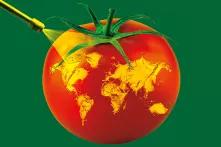
The global pesticide market is growing – and there are only a few corporations that are dividing it up among themselves. They are increasingly investing in countries in the Global South, where pesticides are less strictly regulated.

Agrochemical companies such as Bayer or Syngenta emerged from chemical or pharmaceutical companies – some of which were founded already in the 19th century. In the mid-1990s, with the advent of genetic engineering in agriculture, they discovered a new business model: combining pesticide sales with seed sales. In order to form new specialized groups, they bought up smaller seed producers in large numbers and, around the turn of the millennium, split off the agricultural division from the rest of the business. In recent years, the shares of these corporations in the global market have increased sharply once again. In 2015, the US corporation Dow Chemicals had announced a merger with Dupont. Both companies combined their pesticide and seed businesses to Corteva Agriscience four years later. In 2017, the Chinese state-owned enterprise ChemChina took over the Swiss agricultural group Syngenta. In 2018, the German chemical company Bayer acquired the U.S. company Monsanto and sold parts of its business to German chemical company BASF, which entered the seed business with the acquisition. And in 2020, Syngenta, the Israeli pesticide company Adama, and Sinochem from China were combined to form Syngenta Group.
The top four firms – Syngenta Group, Bayer, Corteva and BASF – controlled around 70 percent of the global pesticide market in 2018. 25 years earlier, their market share was only 29 percent. In the seeds sector – now led by exactly the same groups – the share of the biggest four rose from 21 to 57 percent over the same period.
The power of these players and the continued merging of the two business models have implications for product range and agriculture worldwide: Pesticide selling seed producers have an interest in ensuring that their agrochemicals are also used in the cultivation of their seed. The leading global providers of seeds and pesticides focus on selective breeding and genetic modification of a small number of crops. First and foremost, soybean and maize. They account for about two-thirds of the seed market’s volume. Bayer generates about 75 percent of its seed sales from maize and soybeans, Syngenta 55 percent and Corteva a full 85 percent.
Aiming to further developing seeds, the big companies have increased their research expenditures in recent years, while research expenditure in the agrochemical sector has been stagnating at the same time. In 2000, 70 percent of global agrochemical sales were patented or proprietary formulations. Since then, patents on popular agrochemicals have expired, with no new patented active ingredients to take their position on the market. Meanwhile only 15 percent are patented. One reason for this can be found in stricter approval procedures, largely in the European Union – which led to an increase in cost for bringing a new active ingredient to market. In light of these costs, major firms tend to use older active ingredients, combined in new mixtures.
The best-selling pesticide products include the herbicide glyphosate (patented in 1971, on the market since 1974), paraquat (herbicidal effect discovered in 1955, on the market since 1962), the herbicide atrazine (on the market since 1958) and neonicotinoids, a new class of insecticides (on the market since the early nineties). What they all have in common is that they are considered dangerous: Glyphosate for example is suspected of being carcinogenic, paraquat is highly toxic to humans, atrazine is hormone-disrupting and neonicotinoids are highly toxic to bees.
In industrialized countries, the five largest producers sell less highly dangerous pesticides overall than in Asia, Africa and Latin America: While they account for 12 percent of total pesticide sales in Germany and 11 percent in France, they account in Brazil for 49 percent and in India for 59 percent. One reason for this is that the EU and the countries of the European Free Trade Association (EFTA) have banned several Highly Hazardous Pesticides. Elsewhere, however, these substances are still permitted due to incomplete regulation – especially in South America, Asia, and Africa, where pesticide sales are on the rise.
The continuous growth of the global pesticide market by an average of 4 percent annually is mainly due to sales in these world regions. Africa still uses the least pesticides, with an average of less than 0.4 kilograms per hectare of cropland, while worldwide the figure is around 2.6 kilograms per hectare but is starting to catch up with other regions: Industry has long since identified the African continent as its largest growth market. With the increasing presence of the agricultural industry, the use of Highly Hazardous Pesticides is also increasing.

